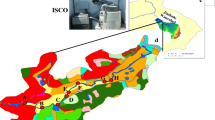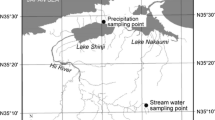Abstract
To clarify nitrogen (N) sources, the overall N budget in a forested watershed in Kanagawa Prefecture, Central Japan was estimated by measuring dissolved inorganic N (DIN; NH4 + + NO3 – + NO2 –) from Nov 2004 through Oct 2005. The estimated N budget (–1.43 kg N ha–1 year–1) showed that the N output rate (stream water N) was higher than the N input rate (bulk deposition N) in the watershed. The annual NO2 – and NO3 – input rates were 0.02 and 1.99 kg N ha–1 year–1, respectively. NH4 + was the predominant source in this forested watershed, accounting for 71% (4.99 kg N ha–1 year–1) of DIN input rate. In addition, this study estimated rainfall pH, air temperature, and wind direction, which were considered as controlling factors related to the atmospheric deposition rate of NH4 +. This study showed that the rainfall NH4 + was inversely proportional to the initial pH of the rainfall, which was calculated by adding the amount of H+ consumed by the dissociation process of NH3(aq) to the measured rainfall pH. This result implies that acid rain can elevate the solubility of NH3(g) and the dissociation capacity of NH4 + throughout the process of precipitation. Also, this study provides strong evidence that the high NH4 + deposition rate is mainly derived from NH3(g) emitted from livestock wastes under the NH3 transport condition of warm summer and favorable wind direction.







Similar content being viewed by others
References
Asman, W. A. H. (1992). Ammonia emission in Europe: updated emission and emission variations. Report 228471008. National Institute of Public Health and Environmental Protection (RIVM), Bilthoven, The Netherlands.
Asman, W. A. H., & van Jaarsveld, J. A. (1992). A variable-resolution transport model applied for NHx in Europe. Atmospheric Environment, 26A, 445–464.
Baba, M., & Okazaki, M. (1998). Acidification in nitrogen-saturated forested catchment. Soil Science and Plant Nutrition, 44, 513–525.
Baba, M., Okazaki, M., & Hashitani, T. (1995). Effect of acidic deposition on forested Andisols in the Tama Hill region of Japan. Environmental Pollution, 89, 97–106.
Battye, R., Battye, W., Overcash, C., & Fudge, S. (1994). Development and selection of ammonia emission factors. EPA Contract Number 68-D3-0034, Work Assignment 0-3, USEPA, Research Triangle Park, NC 27711, USA.
Brimblecombe, P., & Dawson, G. A. (1984). Wet removal of highly soluble gases. Journal of Atmospheric Chemistry, 2, 95–107.
Brown, D. J. A. (1988). Effect of atmospheric N deposition on surface water chemistry and the implications for fisheries. Environmental Pollution, 54, 275–284.
Castro, M. S., & Morgan, R. P., II. (2000). Input-output budgets of major ions for a forested watershed in western Maryland. Water, Air, and Soil Pollution, 119, 121–137.
Chiwa, M., Kim, D. H., & Sakugawa, H. (2003). Rainfall, stemflow, and throughfall chemistry at urban- and mountain-facing sites at Mt, Gokurakuji, Hiroshima, western Japan. Water Air and Soil Pollution, 146, 93–109.
Dise, N. B., & Wright, R. F. (1995). Nitrogen leaching from European forest in relation to nitrogen deposition. Forest Ecology and Management, 71, 153–161.
Driscoll, C. T., & Schafran, G. S. (1984). Short-term changes in the base neutralizing capacity of an acid Adirondack lake, New York. Nature, 310, 308–310.
Emmett, B. A., Stevens, P. A., & Reynolds, B. (1995). Factors influencing nitrogen saturation in Sitka spruce stands in Wales, UK. Water, Air, and Soil Pollution, 85, 1629–1634.
Friendland, A. J., Gregory, R. A., Karenlampi, L., & Johnson, A. H. (1984). Winter damage to foliage as a factor in red spruce decline. Canadian Journal of Forest Research, 14, 963–965.
Galloway, J. N., Schlesinger, W. H., Levy, H., II, Michaels, A., & Schnoor, J. L. (1995). Nitrogen fixation: Anthropogenic enhancement-environmental response. Global Biogeochemical Cycles, 9, 235–252.
Griffin, K. L., Winner, W. E., & Strain, B. R. (1995). Growth and dry matter partitioning in loblolly and ponderosa pine seedlings in response to carbon and nitrogen availability. New Phytologist, 129, 547–556.
Gundersen, P., & Rasmussen, L. (1990). Nitrification in forest soils: Effects from nitrogen deposition on soil acidification and aluminum release. Review of Environmental Contamination and Toxicology, 113, 1–45.
Hales, J. M., & Drewes, D. L. (1979). Solubility of ammonia in water at low concentrations. Atmospheric Environment, 13, 1133–1147.
Hayashi, K., & Okazaki, M. (2002). Effect of volcanic fumes from Mt. Oyama, Miyakejima Island, on atmospheric deposition, soil solution, and soil properties in Kumagaya, Central Japan. Soil Science and Plant Nutrition, 48, 401–411.
Holland, E. A., Dentener, F. J., Braswell, B. H., & Sulzman, J. M. (1999). Contemporary and preindustrial global reactive nitrogen budgets. Biogeochemistry, 46, 7–43.
Japanese government’s Ministry of the Environment. (2008). Annual White Paper on the Environment 2008. Tokyo, Japan: Gyosei. in Japanese.
JSAC Hokkaido Staff. (2000). Water Analyses. The Japanese Society for Analytical Chemistry, Hokkaido Branch, Kyoto, Japan. (in Japanese)
Kannari, A., Baba, T., & Hayami, H. (2001). Estimation of ammonia emission in Japan. Journal of Japanese Society of Atmospheric Environment, 36, 29–38 (in Japanese with English summary).
Matzner, E., & Murach, D. (1995). Soil changes induced by air pollutant deposition and their implication for forests in central Europe. Water, Air, and Soil Pollution, 85, 63–76.
Miyazaki, T., & Besho, O. (1990). Analysis of water quality for groundwater in Nakano area in Tokyo (1). Tokyo, Japan: Nakano Institute of Public Health. in Japanese.
Miyazaki, T., & Besho, O. (1991). Analysis of water quality for groundwater in Nakano area in Tokyo (2). Tokyo, Japan: Nakano Institute of Public Health. in Japanese.
Nihlgard, B. (1985). The ammonium hypothesis. An additional explanation to the forest dieback in Europe. AMBIO, 14, 2–8.
Ohrui, K., & Mitchell, M. J. (1997). Nitrogen saturation in Japanese forested watersheds. Ecological Applications, 7, 391–401.
Ohrui, K., & Mitchell, M. J. (1998). Effects of nitrogen fertilization on stream chemistry of Japanese forested watersheds. Water, Air, and Soil Pollution, 107, 219–235.
Olivier, J. G. J., Bouwman, A. F., Van der Hoek, K. W., & Berdowski, J. J. M. (1998). Global air emission inventories for anthropogenic sources of NOx, NH3, and N2O in 1990. Environmental Pollution, 102, 135–148.
Schulze, E. D. (1989). Air pollution and forest decline in a spruce (Picea abies) forest. Science, 244, 776–783.
Skeffington, R. A., & Willson, E. J. (1988). Excess nitrogen deposition. Issues for consideration. Environmental Pollution, 54, 159–184.
Soikelli, S., & Karenlampi, L. (1984). The effects of nitrogen fertilization on the ultrastructure of mesophyll cells of conifer needles in Northern Finland. European Journal of Forest Pathology, 14, 129–136.
van Breemen, N., & van Dijk, H. F. G. (1988). Ecosystem effects of atmospheric deposition of nitrogen in the Netherlands. Environmental Pollution, 54, 249–274.
van Breemen, N., Burrough, P. A., Velthorst, E. J., van Dobben, H. F., de Wit, T., Ridder, T. B., et al. (1982). Soil acidification from atmospheric ammonium sulphate in forest canopy throughfall. Nature, 299, 548–550.
Vitousek, P. M. (1994). Beyond global warming: Ecology and global change. Ecology, 75, 1861–1876.
Whytemare, A. B., Edmonds, R. L., Aber, J. D., & Lajtha, K. (1997). Influence of excess nitrogen deposition on a white spruce (Picea glauca) stand in southern Alaska. Biogeochemistry, 38, 173–187.
Yamamoto, K. (2000). Estimation of the canopy gap size using two photographs at different heights. Ecological Research, 15, 203–208.
Acknowledgments
This study was supported by the Japanese Ministry of Education, Culture, Sports, Science and Technology (Grant No. 16500561). Authors would like to express special thanks to Mr. Yasuhiro Tsuneda, Mr. Shou Iwasaki, and Mr. Katsushi Uehara (Musashi Institute of Technology) for their assistance with sample collection and laboratory analysis. Authors greatly acknowledge Dr. Abraham J. Miller-Rushing (USA National Phenology Network and The Wildlife Society) for his advice for this article.
Author information
Authors and Affiliations
Corresponding author
Additional information
An erratum to this article can be found at http://dx.doi.org/10.1007/s11270-010-0415-z
Rights and permissions
About this article
Cite this article
Ham, YS., Kobori, H., Kang, JH. et al. Ammonium Nitrogen Deposition as a Dominant Source of Nitrogen in a Forested Watershed Experiencing Acid Rain in Central Japan. Water Air Soil Pollut 212, 337–344 (2010). https://doi.org/10.1007/s11270-010-0347-7
Received:
Accepted:
Published:
Issue Date:
DOI: https://doi.org/10.1007/s11270-010-0347-7




